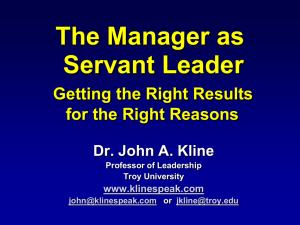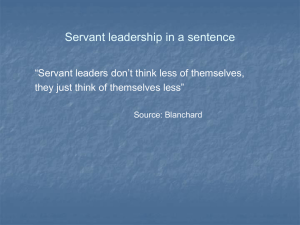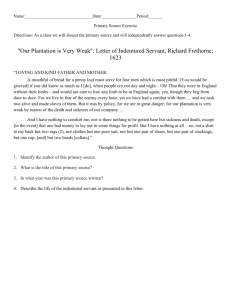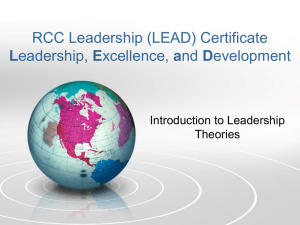Transformational leaders to servant leaders versus level 4
advertisement
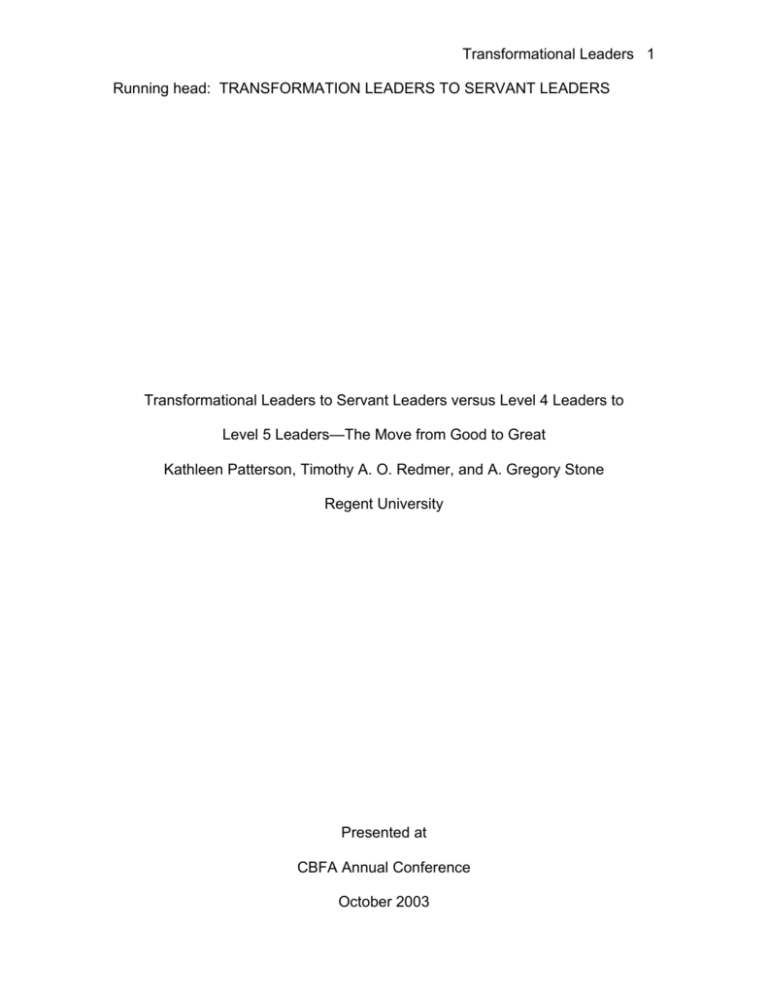
Transformational Leaders 1 Running head: TRANSFORMATION LEADERS TO SERVANT LEADERS Transformational Leaders to Servant Leaders versus Level 4 Leaders to Level 5 Leaders—The Move from Good to Great Kathleen Patterson, Timothy A. O. Redmer, and A. Gregory Stone Regent University Presented at CBFA Annual Conference October 2003 Transformational Leaders 2 Introduction Both researchers and practitioners have gravitated to transformational leadership (Burns 1978; Bass 1985a) and have employed it in a variety of organizational settings. Similarly, the concept of servant leadership, which Robert Greenleaf (1977) formulated in the modern era, has received substantial attention in the contemporary leadership field. A cursory glimpse of transformational leadership and servant leadership leaves the perception that the concepts are rather similar. In fact, some individuals question whether there is any real difference between the concepts. In his bestseller book, Good to Great, Jim Collins identified several critical factors that distinguish good companies from great companies. He and his research team designed, developed, and conducted an empirical research study that examined companies categorized as transitioning from good to great companies. To qualify as a company that moved from good to great, the research team used the following measurable criteria (2001, p, 6): The company's fifteen-year cumulative stock returns had to be at or below the general stock market, punctuated by a transition point, and then cumulative returns had to be at least three times the market value over the next fifteen years. The good-to-great company performance had to be independent of its industry. Reviewing data for the 30-year time period from 1965 to 1995 resulted in 11 companies qualifying for the good-to-great status. The research team also identified 11 comparison companies in the same industries that did not achieve a Transformational Leaders 3 good-to-great status and 6 unsustained companies that made a switch from good-to-great, but could not sustain their position. Once the research sample of 28 companies was identified, the study attempted to identify the critical distinguishing factors between the good-to-great companies and the other companies in the sample. The first distinguishing factor identified by Collins (2001), and maybe the most important, was defined as Level 5 Leadership. Collins defined Level 5 leadership for the chief executive officer of the good-to-great companies as personal humility plus professional will (p. 22). Purpose of this Paper A cursory glimpse of Collins' Level 4 leadership and the Level 5 leadership leaves the perception that the concepts are similar, as seen in Table 1. Table 1 Change in Leader Focus from Level 4 Leader to Level 5 Leader A “Genius with a Thousand Helpers” (Comparison Companies) LEVEL 4 LEADER Level 5 + Management Team (Good-to-Great Companies) LEVEL 5 LEADER First What Set a vision for where to drive the bus. Develop a road map for driving the bus. First Who Get the right people on the bus. Build a superior executive team. Then Who Enlist a crew of highly capable “helpers” to make the vision happen Then What Once you have the right people in place, figure out the best path to greatness. Transformational Leaders 4 A glimpse of transformational leadership and servant leadership leaves a similar perception that the concepts are more alike than different. Some question whether there is any real difference between the concepts at all. The premise of this article is that transformational leaders tend to focus more on organizational objectives while servant leaders focus more on the people who are their followers. Congruently, the difference between Level 4 leaders and Level 5 leaders are the leader's ability to shift focus from the organization to its people. Consequently, there is a commonality between the servant leader and the leader operating at Level 5. This tendency of the Level 5 leader and the servant leader to focus on their followers appears to be the primary factor that distinguishes servant leadership from transformational leadership as well as the Level 5 leaders from Level 4 leaders. The remainder of this article explores the areas in which the theoretical constructs of servant leadership overlap with the concepts of Level 5 leadership. The Servant Leader In her dissertation, Kathleen Patterson (2003) developed a working definition of servant leadership as signifying those leaders who lead an organization by focusing on their followers, such that the followers are the primary concern and the organization concerns are peripheral. The majority of her research centered on the specific virtues of servant leadership and why these virtues were part of a servant-leadership philosophy for the chief executive officer. Specifically, Patterson (2003) identified the servant leadership virtues as: love, humility, altruism, vision, trust, empowerment, and service. Transformational Leaders 5 Moving from Transformational to Servant Leadership One may ask what the real difference is, if any, between transformational leadership and servant leadership. Is servant leadership just a subset of transformational leadership or vice versa? Are transformational leadership and servant leadership the same theory, except for their use of different names? The side-by-side comparison in Table 2 reveals that transformational leadership and servant leadership have relatively analogous characteristics. Both transformational and servant leadership are attempts to define and explain people-oriented leadership styles. According to both concepts, their leadership frameworks incorporate the following: influence, vision, trust, respect or credibility, risk-sharing or delegation, integrity, and modeling. Table 2 Comparison of Attributes Transformational Leadership Servant Leadership Idealized (Charismatic) Influence Vision Trust Respect Risk-Sharing Integrity Modeling Influence Vision Trust Credibility & Competence Delegation Honesty & Integrity Modeling & Visibility Service Inspirational Motivation Commitment to Goals Communication Enthusiasm Stewardship Communication Intellectual Stimulation Rationality Problem Solving Persuasion Pioneering Individualized Consideration Personal Attention Mentoring Listening Empowerment Appreciation of Others Encouragement Teaching Listening Empowerment Transformational Leaders 6 Both transformational leadership and servant leadership emphasize the importance of appreciating and valuing people, listening, mentoring or teaching, and empowering followers. The theories are probably most similar in their emphasis upon individualized consideration and appreciation of followers. Nevertheless, transformational leadership and servant leadership do have points of variation. There is a much greater emphasis upon service of followers and service to followers in the servant leadership paradigm. Furthermore, while both transformational leaders and servant leaders are influential, servant leaders gain influence in a nontraditional manner derived from servanthood itself (Russell & Stone, 2002). In so doing, they allow extraordinary freedom for followers to exercise their own abilities. They also place a much higher degree of trust in their followers than would be the case in any leadership style that required the leader to be somewhat directive. Nonetheless, they ultimately form a distinctly separate theoretical framework of leadership because of a primary difference. The principal difference between transformational leadership and servant leadership is the focus of the leader. While transformational leaders and servant leaders both show concern for their followers, the overriding focus of the servant leader is on service to their followers. Transformational leaders have a greater concern for getting followers to engage in and support organizational objectives. The extent to which the leader is able to shift the primary focus of his or her leadership from the organization to the follower is the distinguishing factor in determining whether the leader may be a transformational or servant leader. Transformational Leaders 7 With transformational leadership, the leader's focus is directed toward the organization, and his or her behavior builds follower commitment toward the organizational objectives through empowering followers to accomplish those objectives (Yukl, 1998). The transformational leader inspires followers to higher levels of performance for the sake of the organization (Burns, 1998; Yukl, 1998). The very definition of transformational leadership states the building of commitment to the organizational objectives (Yukl, 1998). The primary focus is on the organization, with follower development and empowerment secondary to accomplishing the organizational objectives. The result, nonetheless, is enhanced follower performance (Burns, 1998; Yukl, 1998). In contrast, the servant leader is one who focuses on his or her followers. Servant leaders do not have particular affinity for the abstract corporation or organization; rather, they value the people who constitute the organization. This is not an emotional endeavor but rather an unconditional concern for the wellbeing of those who form the entity. This relational context is where the servant leader actually leads. Harvey (2001) states that "chasing profits is peripheral; the real point of business is to serve as one of the institutions through which society develops and exercises the capacity for constructive action" (p. 38-39). The servant leader does not serve with a focus on results; rather the servant leader focuses on service itself. Lubin (2001) proffers that the servant leader's first responsibilities are relationships and people, and those relationships take precedence over the task and product. Servant leaders trust their followers to undertake actions that are in the best interest of the organization, even though the leaders do not primarily focus on organizational objectives. Transformational Leaders 8 According to Bass (2000), servant leadership is "close to the transformational components of inspiration and individualized consideration" (p. 33). However, the stress of servant leadership is upon the leader’s aim to serve. This desire to serve people supersedes organizational objectives. Servant leadership is a belief that organizational goals will be achieved on a long-term basis only by first facilitating the growth, development, and general well-being of the individuals who comprise the organization. Conversely, Bass states that transformational leaders strive to align their own and others’ interests with the good of the group, organization, or society. The primary aim is organizational conformance and performance more than it is service to and facilitation of followers. Harvey (2001) contends that the servant leader’s primary objective is the workers and their growth, then the customer base, and finally the organizational bottom line. The Level 5 Leader The first distinguishing factor between the good-to-great companies identified by Collins, and maybe the most important, was defined as Level 5 Leadership. Simply defined, Level 5 leadership, for the chief executive officer of the good to great companies, was personal humility plus professional will (Collins, 2001, p. 22). The characteristics of personal humility for the Level 5 chief executive officer included: Modesty Quiet, calm determination Relying principally on inspired standards Transformational Leaders 9 Ambition for the company versus self Giving credit for success to other people, external factors, and luck A closer look at the characteristics of personal humility further defines a Level 5 leader. When conducting the leader interviews for Good to Great, words such as quiet, humble, modest, reserved, shy, gracious, mild-mannered, selfeffacing, understated, and did not believe his own clippings were used to describe the chief executive officer (Collins, 2001, p. 27). These qualities could easily be related to the qualities of a servant leader discussed later in the paper. One of the potentially strongest servant leadership qualifications of the Level 5 leader is the focus on setting up even greater success for successors than for self. The Level 5 leader desires success of the company and others after his tenure as chief executive officer is over. Also, while being in the leadership position, the Level 5 leader is quick to give others credit for success. This effort at serving others certainly follows a “Golden Rule” philosophy and provides the opportunity for subordinates to reciprocate with quality performance. Collins (2001) also speculated that a strong religious belief or conversion might also nurture development of Level 5 traits (p. 37). Some, but not all, of the leaders featured in Good to Great displayed a religious faith, which could be pivotal in defining quality leadership characteristics. It is certainly possible that leaders with strong religious convictions will transfer those principles to the workplace. One might easily conclude that businesses based on these religious beliefs could exhibit superior performance. The characteristics of professional will for the Level 5 chief executive officer included: Transformational Leaders 10 Creating superb results Possessing unwavering resolve for long-term results Setting a standard of nothing less than building an enduring great company Taking responsibility for poor results versus blaming other people, external factors, and luck A quality just as important as humility for the Level 5 leader is an unwavering resolve to do what must be done to make a company great. When the Collins (2001) research team attempted to describe the leadership style of the good-to-great chief executive officers, they felt the terms “selfless executive” or “servant leader” sounded weak or meek and did not appropriately include the tenacious professional will to get results (p. 30). A closer look at the characteristics supporting professional will show that the chief executive officer is focused on nothing less than the best long-term results for the company. The Level 5 leader is generally quick to take responsibility for poor performance, while at the same time giving credit to others for good performance—a servant leadership quality. An issue that needs to be considered is if servant leadership displays qualities similar to the professional resolve qualities of the Level 5 leader. A further discussion of servant leadership will help to identify similarities and differences between these leadership classifications. Servant Leadership and the Level 5 Leader In this context, servant leadership displays some similarities to Level 5 leadership, specifically in the area of humility, although this is not the only Transformational Leaders 11 connection. Level 5 leadership is noted as a style in which the leader asks “who” rather than “what” (Collins, 2001, p. 42). This focus on who, rather than what, is directly related to servant leadership, where leaders are focused directly on the people they serve. "The good-to-great leaders understood three simple truths. First, if you begin with ‘who,’ rather than ‘what,’ you can more easily adapt to a changing world" (p. 42). "First who" is a very simple idea to grasp, and a very difficult idea to do— and most don't do it well. David Maxwell, CEO of Fannie Mae, during its most financially challenging times, took great risks to put the "first who" into play in his company. As Collins explained, "It's easy to talk about paying attention to people decisions, but how many executives have the discipline of David Maxwell, who held off on developing a strategy until he got the right people in place, while the company was losing $1 million every single business day with $56 billion of loans underwater?” (Collins, 2001, p. 44). Collins repeatedly emphasizes the need to get the right people "on the bus," putting the right team together, or ensuring that the management team is comprised of the people with values that are in sync. This emphasis on "first who" is a direct match to the servant leader's focus on serving the people as the highest of priorities. Vision and Focus Vision is to servant leadership as focus is to Level 5 leadership. Vision is most often regarded as the organizational vision, or destination of the organization. However, the servant leader’s focus is on the individual, and thus the vision aspect is a bit different. Vision for the servant leader refers to the idea Transformational Leaders 12 that the leader can see a person as a viable and worthy person, believes in their future state, and thus seeks to serve them as such. Harvey (2001) notes Greenleaf's formulation of servant leaders as healers, making the person whole by helping that person to the larger vision or purpose than they might be able to attain for themselves. Vision, for the servant leader, is looking at how one could be and creating a mutual respect that values people (Marsh & Conley, 1999; Swindoll, 1981). Collins (2001) reflects vision through the application of compensation and incentives as a long-term strategy. "Yes, compensation and incentives are important, but for very different reasons in good-to-great companies. The purpose of a compensation system should not be to get the right behaviors from the wrong people, but to get the right people on the bus in the first place, and to keep them there" (p. 50). Farling, Stone, and Winston (1999) offer that vision is an aspect of servant leadership, as does Greenleaf (1977), who goes further to state that the primary question leaders must ask themselves is: Are the people they are serving growing? Buchen (1998) also advocates that the futuristic state was very important to Greenleaf and that servant leaders must also be preoccupied with the future; this futuristic view seeks to best serve the constituents by fully knowing where things are headed and what lies in the future. It asks the difficult question: Are the constituents being served with the end in mind? Buchen also notes that the value of servant leaders lies in that they are able to see the handwriting on the wall and are able to distinguish between future change and future fads and act accordingly. Joe Anderson (personal Transformational Leaders 13 communication, January 17, 2003) states that the servant leader’s vision for others is about faith, about seeing and speaking things as though they are or will be. The servant leader must dream while remaining in the past and focused on the future (Bennett, 2001). This allows the leader to take advantage of the opportunities of the present. Servant leadership requires the leader to cultivate a forward-looking atmosphere (Wis, 2002). This looking ahead, according to Melrose (1995), calls the servant leader to have faith and vision not for what is, but for what can be, which fosters a great capacity for growth. This vision builds the belief that one can improve, step forward, and reach goals. Collins’ (2001) Level 5 leader also sees the employee for who he can be instead of for who he is in his current state. In determining ‘the right people,’ the good-to-great companies placed greater weight on character attributes than on specific educational background, practical skills, specialized knowledge, or work experience. Not that specific knowledge or skills are unimportant, but they viewed these traits as more teachable (or at least learnable), whereas they believed dimensions like character, work ethic, basic intelligence, dedication to fulfilling commitments, and values are more ingrained. (p. 51) For the servant leader to be visionary, he or she senses the unknowable and is able to see the bigger picture (Wis, 2000). This process includes seeing each person’s unique gifts and influences the decisions of the leader as well as helps the leader shape a plan for the future, all while asking if the people are being served. Roger Stevens (personal communication, January 13, 2003) Transformational Leaders 14 would agree; he feels that knowing people’s abilities and seeing where they are headed is imperative to serve them properly. The visionary servant leader also knows the followers and helps them develop clear feelings of purpose, direction, and dignity (Batten, 1998). Melrose (1995) proffers that servant leaders enrich lives, build better human beings, and encourage people to become more than they ever believed. This is more than a job; this deep-rooted leadership is about mission—the mission to serve. Altruism—A Different Corporate Culture Kaplan (2000) states that altruism is helping others selflessly just for the sake of helping, which involves personal sacrifice with no thought of personal gain. Sometimes this involves one going against one’s own personal interest. This is congruent with DeYoung (2000), who states the traditional view of altruism as an unselfish concern for others often involving personal sacrifice. However, the idea of personal pleasure from helping others should also be included in understanding altruism. It is sometimes believed that an altruistic approach is one end of the spectrum with personal self-interest at the other end (Hattwick, 1996). Sosik (2000) offers that altruism is the fulfillment of another person with behavior directed toward this other person, and further that this behavior is consistent with servant leadership. Sosik offers Bishop Desmond Tutu, Sam Walton, Mother Teresa, and Princess Diana as examples of altruistic people who were concerned for others. According to Berry and Cartwright (2000), the servant leader seeks "radical equality" in the treatment of all people, which is an altruistic approach. In an interview with Herb Kelleher of Southwest Airlines (Air Herb's secret weapon, Transformational Leaders 15 1999), Kelleher states that the attitude of Southwest Airlines is humility and modesty, selflessness and altruism, and further, that altruism is shown by people doing for others instead of doing for themselves. Kelleher states that his company seeks to hire people with this servant leadership mentality. People with this attitude and mentality are capable of being leaders and rising through the ranks. Pielstick (2000) states authentic leaders treat everyone with dignity and respect. These servant leaders are altruistic, humble, and fair. They exhibit altruism while emphasizing service and this service orientation for the leader is more important than the self is. Collins specifically notes “if you don’t have what it takes you probably won’t last long” and emphasizes throughout his book that it is imperative that the executive have the right people on the bus (Collins, 2001, p. 52). Empowerment According to Collins, "The moment you feel the need to tightly manage someone, you've made a hiring mistake. The best people don't need to be managed. Guided, taught, led—yes. But not tightly managed" (Collins, 2001, p. 56). Buchen (1998) attributes Greenleaf as the father of the empowerment movement and states that empowerment is one of the most important characteristics of servant leadership. Russell and Stone (2002) agree that empowerment is a central element in excellent leadership, specifically servant leadership. Veronesi (2001) proffers that servant leadership involves nothing more than sharing power and empowering people with the best interest of those Transformational Leaders 16 served in mind. Servant leadership is based in empowerment, with an emphasis on equality (Kezar, 2002). Empowerment is entrusting power to others and for the servant leader it involves listening effectively, making people feel significant, emphasizing teamwork, and valuing love and equality (Russell & Stone, 2002). Lubin (2001) proffers the idea that servant leaders are committed to the growth of their people. This growth is personal, professional, and spiritual. Servant leaders empower by teaching and developing people (Russell & Stone, 2002). Servant leaders' satisfaction comes from the growth of others and they are willing to hold themselves accountable for the results (Blanchard, 2000). Bennett (2001) states that servant leaders need to know their followers and understand their need for knowledge and experience. Collins emphasized one of the best practical applications of empowerment through the manner in which the good-to-great companies assigned their best employees. The good-to-great companies made a habit of putting their best people on their best opportunities, not their biggest problems. The comparison companies had a penchant for doing just the opposite, failing to grasp the fact that managing your problems can only make you good, whereas building your opportunities is the only way to become great. (Collins, 2001, p. 59) Farling, Stone, and Winston (1999) state that servant leaders empower followers in accordance with acting on their values and that this relationship is transforming. The idea of empowerment and servant leadership go hand in hand in that servant leadership is all about service, a wholistic approach to work, Transformational Leaders 17 personal development, and shared decision making. Further, servant leadership is about respecting feelings (Lee & Zemke, 1993). Russell (2001) proffers that servant leaders have as a goal of empowerment, to create many leaders at all levels. This power sharing enables and involves others. Melrose (1995) believes that servant leadership involves giving people chances to move in new directions by preserving their roots, respecting their value, and preserving their dignity. Covey (2002) offers that empowerment is a role of the leader and that the servant leader is a model, a pathfinder, and an aligner of vision and people. This empowerment model shows the leader as the one who empowers followers to find their own paths, and those people are inspired to help others find paths. Joe Anderson (personal communication, January 17, 2003) shares that empowerment is enabling others—really giving power—and that servant leaders know that they work for the people and not that the people work for them. Covey also advocates that empowerment from the servant leader is seeking to understand the person, his concerns, and his interests, and that the key to empowerment is listening to others and valuing the differences. Melrose (1995) states empowerment involves clarification of expectations, goals, and responsibilities. Further, it involves allowing for self-direction and freedom to fail. The servant leader creates the environment where people can achieve their potential and work toward their goals. This empowerment involves letting people do their jobs by enabling them to learn, grow, and progress; this multiplies their strengths and trust. Melrose proffers that servant leaders, by empowering followers, are allowing them freedom to proceed, helping people Transformational Leaders 18 make dreams reality. This empowerment is giving up control and letting the followers take charge as needed. Throughout this process, the servant leader is channeling followers, is balancing the growth of followers, and is aware of what is best for the follower, which in turn allows the follower to bloom and grow. Summary Both servant leaders and Level 5 leaders are visionaries, generate high levels of trust, serve as role models, show consideration for others, delegate responsibilities, empower followers, teach, communicate, listen, and influence followers. Certainly, servant leaders and Level 5 leaders are not antithetical—in fact, they may be the same leaders. Further research may determine if they are one in the same! They are complementary ideologies because they both describe excellent forms of leadership. These authors recommend further study to pursue understanding the servant leader and the Level 5 leader. The world has become more complicated, and dynamic times require dynamic, driven leaders (Williams, 1998). Both servant leaders and Level 5 leaders offer the conceptual framework for dynamic leadership. While transformational leadership has been well researched and has become popular in practice, servant leadership theory needs further research and empirical support. Given that there is some association between servant leadership and Level 5 leadership, empirical studies can be developed and implemented to determine the extent and significance of those relationships. Any resulting ability to measure the impact of leadership styles on outcomes and performance can result in obvious benefits in supporting casual relationships and the further Transformational Leaders 19 development of Patterson and Stone's servant leadership theory. Nonetheless, servant leadership offers great opportunities for leaders. Servant leaders and Level 5 leaders can bring about real change in organizations. When followers recognize that their leaders truly follow the ideals of servant leadership and the principles of Level 5 leadership, they are apparently more likely to move in the direction of servants and Level 5 leaders themselves, which decreases customer churn and increases long-term profitability and success (Braham, 1999). Overall, both servant leaders and Level 5 leaders offer valid, practical application paradigms for contemporary leadership in all types of organizations and for leaders who are willing to swim against the stream of prevailing thought and practice to move to the next level of performance in their organizations. Transformational Leaders 20 References Air Herb's secret weapon. (1999). Chief Executive, 146, 32. Bass, B. M. (1985a). Leadership and performance beyond expectations. New York, NY: The Free Press. Bass, B. M. (2000). The future of leadership in learning organizations. Journal of Leadership Studies, 7, 18-40. Batten, J. (1998). Servant-leadership: A passion to serve. In L. C. Spears. (1998). Insights on Leadership: Service, Stewardship, Spirit, and ServantLeadership. (pp. 38-53). New York: John Wiley & Sons, Inc. Bennett, J. L. (2001). Trainers as leaders of learning. Training and Development, 55, 43. Berry, A. J., & Cartwright, S. (2000). Leadership: A critical construction. Leadership & Organization Development Journal, 21, 342-349. Braham, J. (1999). The spiritual side. Industry Week, 48-56. Buchen, I. H. (1998). Servant leadership: A model for future faculty and future institutions. Journal of Leadership Studies, 5, 125. Burns, J. M. (1998). Transactional and transforming leadership. In G. R. Hickman (Ed.), Leading Organizations. (pp. 133-134). Thousand Oaks, CA: Sage Publications. Collins, J. (2001). Good to great: Why some companies make the leap . . . and others don’t. New York: Harper Collins Publishing. 1, 2 Covey, S. (2002). Servant-leadership and community leadership in the twentyfirst century. In, Spears, L. (Eds). Focus on Leadership: Servant- Transformational Leaders 21 Leadership for the 21st Century. (pp. 27-34). New York: John Wiley & Sons, Inc. DeYoung, R. (2000). Expanding and evaluating motives for environmentally responsible behavior. Journal of Social Issues, 56, 509. Farling, M. L., Stone, A. G., & Winston, B. E. (1999). Servant leadership: Setting the stage for empirical research. The Journal of Leadership Studies, 6, 49-72. Greenleaf, R. K. (1977). Servant leadership: A journey into the nature of legitimate power and greatness. New York: Paulist Press. Harvey, M. (2001). The hidden force: A critique of normative approaches to business leadership. SAM Advanced Management Journal, 66, 36-48. Hattwick, R. E. (1996). The heart of altruism. The Journal of Socio-Economics, 25, 722-724. Kaplan, S. (2000). Human nature and environmentally responsible behavior. Journal of Social Issues, 56, 491. Kezar, A. (2002). Reconstructing static images of leadership: an application of positionality theory. Journal of Leadership Studies, 8, 94. Lee, C., & Zemke, R. (1993). The search for spirit in the workplace. Training, 30, 21. Lubin, K. A. (2001). Visionary leader behaviors and their congruency with servant leadership characteristics. Dissertation Abstracts Online, retrieved 2002. Melrose, K. (1995). Making the grass greener on your side: A CEO's journey to leading by serving. San Francisco: Berrett-Koehler Publishers, Inc. Transformational Leaders 22 Patterson, K. (2003). Servant leadership: A theoretical model. Unpublished doctoral dissertation, Regent University, Virginia Beach, VA. Pielstick, C. D. (2000). Formal vs. informal leading: A comparative analysis. Journal of Leadership Studies, 7, 99. Russell, R. F. (2001). The role of values in servant leadership. Leadership & Organization Development Journal, 22, 76-84. Russell, R. F., & Stone, A. G. (2002). A review of servant leadership attributes: Developing a practical model. Leadership and Organization Development Journal, 23, 145-157. Sosik, J. J. (2000). The role of personal meaning in charismatic leadership. The Journal of Leadership Studies, 7, 60. Swindoll, C. R. (1981). Improving your serve. Dallas: Word Publishing. Veronesi, J.F. (2001). Producing a Caring Environment for Staff: Forging Old Paradigms. Nursing Administration Quarterly, v25 i3 p69. Wagner-Marsh, F., & Conley, J. (1999). The fourth wave: the spiritually-based firm. Journal of Organizational Change Management, 12, 292. Williams, L. E. (1998). Servants of the people: The 1960’s legacy of AfricanAmerican leadership. New York: St. Martin’s Press. Wis, R. M. (2002). The conductor as servant leader. Music Educators Journal, 89, 17. Yukl, G. (1998). Leadership in organizations (4th ed.). Upper Saddle River, NJ: Prentice-Hall, Inc.



